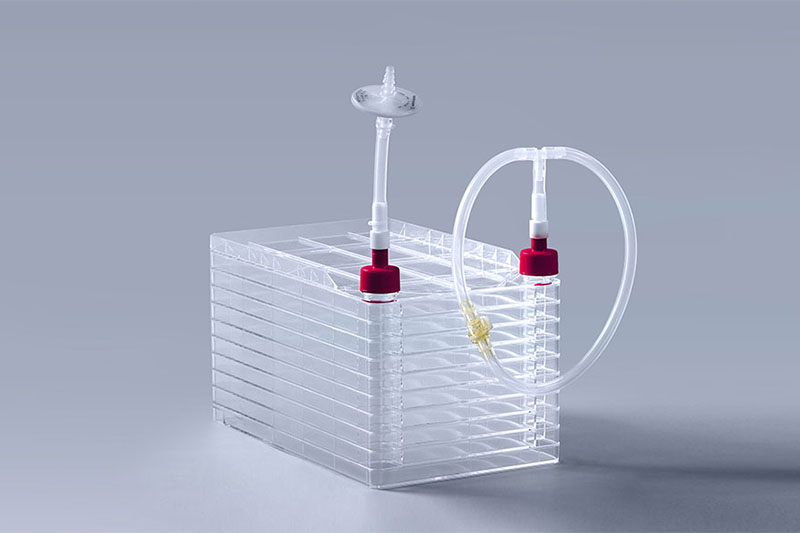Operating a cell factory involves the controlled cultivation and manipulation of cells to produce specific products or compounds. Cell factories are commonly used in biotechnology, pharmaceuticals, and industrial processes. Here's a general overview of how to operate a cell factory:
1.Select the Host Organism:
Choose a suitable host organism for your specific application. Common choices include bacteria (e.g., Escherichia coli), yeast (e.g., Saccharomyces cerevisiae), mammalian cells (e.g., Chinese hamster ovary cells), and plant cells.
The choice of host organism depends on factors such as the product to be produced, scalability, and the ability to genetically engineer the organism.
2.Genetic Engineering:
If necessary, genetically modify the host organism to make it capable of producing the desired product or compound.
Introduce or modify genes within the host's genome to enable the production of the target molecule.
3.Cultivation:
Grow the genetically modified cells in a controlled environment, typically within bioreactors or fermenters.
Provide the necessary nutrients, oxygen, temperature, pH, and agitation to support cell growth and product formation.
4.Monitoring and Control:
Continuously monitor critical parameters, including cell density, nutrient concentrations, pH, dissolved oxygen levels, and temperature.
Use feedback control systems to maintain optimal conditions for cell growth and product synthesis.
5.Induction or Triggering:
Depending on the system, induce or trigger the production of the desired product. This might involve adding specific chemicals, changing the culture conditions, or using inducible promoters in the genetically modified cells.
6.Harvesting:
When the cells have reached the desired growth phase and have produced the target product, it's time to harvest them.
Harvesting methods can vary based on the cell type and product but may involve centrifugation, filtration, or cell disruption techniques.
7.Product Recovery:
Extract the target product from the harvested cells or culture medium. This often requires purification steps such as chromatography, filtration, and precipitation.
Concentrate and purify the product to achieve the desired quality and quantity.
8.Quality Control:
Perform rigorous quality control tests to ensure that the product meets specifications for purity, concentration, and functionality.
Analyze samples for contaminants, impurities, and product stability.
9.Scaling Up:
If necessary, scale up the cell factory operation to produce larger quantities of the product.
Transition from lab-scale bioreactors to larger industrial-scale bioreactors while maintaining process consistency and quality.
10.Storage and Distribution:
Store the final product under appropriate conditions to maintain its stability.
Distribute the product to end-users or customers according to regulatory requirements.
11.Documentation and Compliance:
Maintain detailed records of all processes and adhere to regulatory guidelines and quality control standards, especially if the product is intended for pharmaceutical or clinical use.
12.Continuous Improvement:
Continuously evaluate and optimize the cell factory system to improve productivity, reduce production costs, and enhance product quality.
Operating a cell factory requires expertise in bioprocessing, genetics, and quality control. Additionally, it's essential to keep up with advances in biotechnology and stay compliant with relevant regulations and standards in your industry.
The FAI climbed 5.9 percent year-on-year in the first 11 months of 2018, quickening from the 5.7-percent growth in Jan-Oct, the National Bureau of Statistics (NBS) said Friday in an online statement.
The key indicator of investment, dubbed a major growth driver, hit the bottom in August and has since started to rebound steadily.
In the face of emerging economic challenges home and abroad, China has stepped up efforts to stabilize investment, in particular rolling out measures to motivate private investors and channel funds into infrastructure.
Friday's data showed private investment, accounting for more than 60 percent of the total FAI, expanded by a brisk 8.7 percent.
NBS spokesperson Mao Shengyong said funds into weak economic links registered rapid increases as investment in environmental protection and agriculture jumped 42 percent and 12.5 percent respectively, much faster than the average.
In breakdown, investment in high-tech and equipment manufacturing remained vigorous with 16.1-percent and 11.6-percent increases respectively in the first 11 months. Infrastructure investment gained 3.7 percent, staying flat. Investment in property development rose 9.7 percent, also unchanged.
 English
English



















































 Cell Factory
Cell Factory